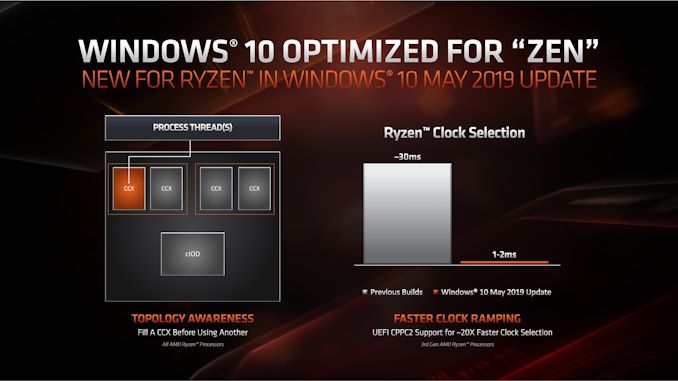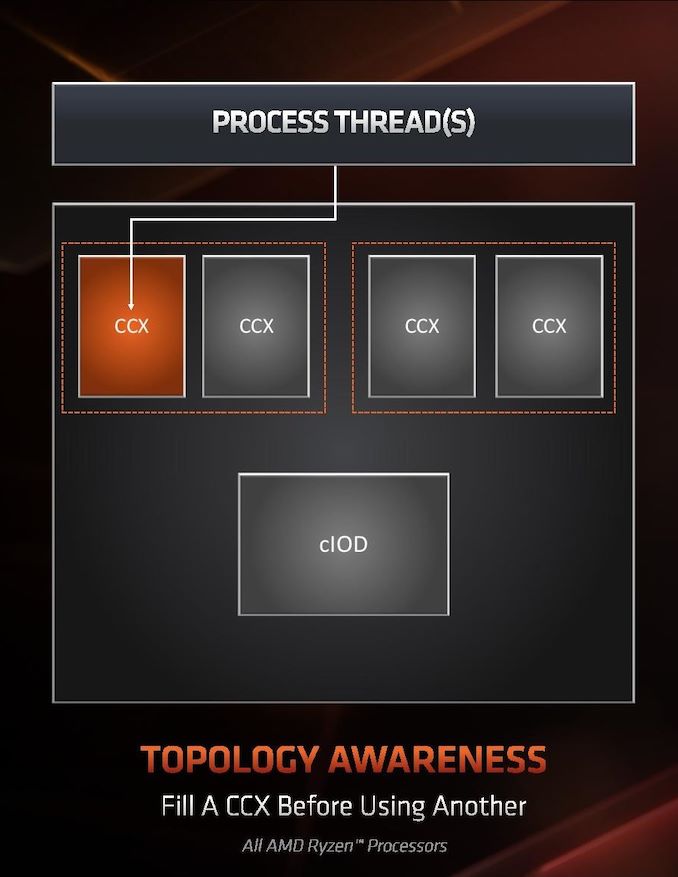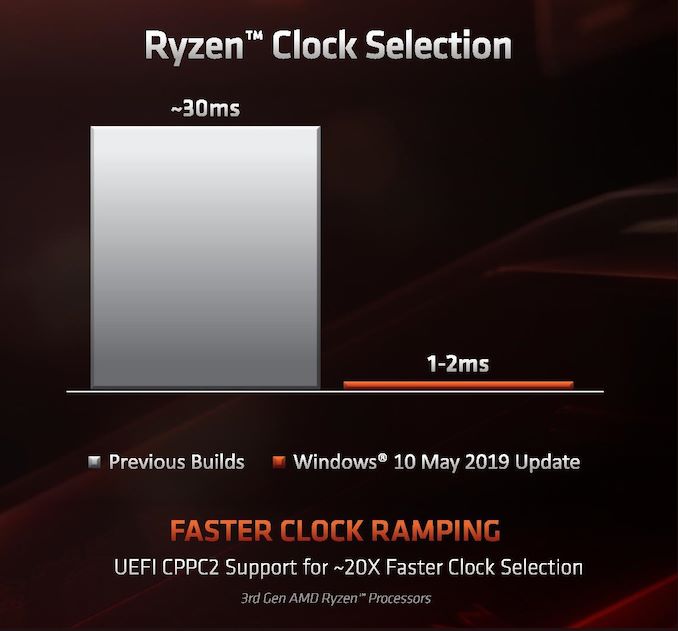AMD Zen 2 Microarchitecture Analysis: Ryzen 3000 and EPYC Rome
by Dr. Ian Cutress on June 10, 2019 7:22 PM EST- Posted in
- CPUs
- AMD
- Ryzen
- EPYC
- Infinity Fabric
- PCIe 4.0
- Zen 2
- Rome
- Ryzen 3000
- Ryzen 3rd Gen
Windows Optimizations
One of the key points that have been a pain in the side of non-Intel processors using Windows has been the optimizations and scheduler arrangements in the operating system. We’ve seen in the past how Windows has not been kind to non-Intel microarchitecture layouts, such as AMD’s previous module design in Bulldozer, the Qualcomm hybrid CPU strategy with Windows on Snapdragon, and more recently with multi-die arrangements on Threadripper that introduce different memory latency domains into consumer computing.
Obviously AMD has a close relationship with Microsoft when it comes down to identifying a non-regular core topology with a processor, and the two companies work towards ensuring that thread and memory assignments, absent of program driven direction, attempt to make the most out of the system. With the May 10th update to Windows, some additional features have been put in place to get the most out of the upcoming Zen 2 microarchitecture and Ryzen 3000 silicon layouts.
The optimizations come on two fronts, both of which are reasonably easy to explain.
Thread Grouping
The first is thread allocation. When a processor has different ‘groups’ of CPU cores, there are different ways in which threads are allocated, all of which have pros and cons. The two extremes for thread allocation come down to thread grouping and thread expansion.
Thread grouping is where as new threads are spawned, they will be allocated onto cores directly next to cores that already have threads. This keeps the threads close together, for thread-to-thread communication, however it can create regions of high power density, especially when there are many cores on the processor but only a couple are active.
Thread expansion is where cores are placed as far away from each other as possible. In AMD’s case, this would mean a second thread spawning on a different chiplet, or a different core complex/CCX, as far away as possible. This allows the CPU to maintain high performance by not having regions of high power density, typically providing the best turbo performance across multiple threads.
The danger of thread expansion is when a program spawns two threads that end up on different sides of the CPU. In Threadripper, this could even mean that the second thread was on a part of the CPU that had a long memory latency, causing an imbalance in the potential performance between the two threads, even though the cores those threads were on would have been at the higher turbo frequency.
Because of how modern software, and in particular video games, are now spawning multiple threads rather than relying on a single thread, and those threads need to talk to each other, AMD is moving from a hybrid thread expansion technique to a thread grouping technique. This means that one CCX will fill up with threads before another CCX is even accessed. AMD believes that despite the potential for high power density within a chiplet, while the other might be inactive, is still worth it for overall performance.
For Matisse, this should afford a nice improvement for limited thread scenarios, and on the face of the technology, gaming. It will be interesting to see how much of an affect this has on the upcoming EPYC Rome CPUs or future Threadripper designs. The single benchmark AMD provided in its explanation was Rocket League at 1080p Low, which reported a +15% frame rate gain.
Clock Ramping
For any of our users familiar with our Skylake microarchitecture deep dive, you may remember that Intel introduced a new feature called Speed Shift that enabled the processor to adjust between different P-states more freely, as well as ramping from idle to load very quickly – from 100 ms to 40ms in the first version in Skylake, then down to 15 ms with Kaby Lake. It did this by handing P-state control back from the OS to the processor, which reacted based on instruction throughput and request. With Zen 2, AMD is now enabling the same feature.
AMD already has sufficiently more granularity in its frequency adjustments over Intel, allowing for 25 MHz differences rather than 100 MHz differences, however enabling a faster ramp-to-load frequency jump is going to help AMD when it comes to very burst-driven workloads, such as WebXPRT (Intel’s favorite for this sort of demonstration). According to AMD, the way that this has been implemented with Zen 2 will require BIOS updates as well as moving to the Windows May 10th update, but it will reduce frequency ramping from ~30 milliseconds on Zen to ~1-2 milliseconds on Zen 2. It should be noted that this is much faster than the numbers Intel tends to provide.
The technical name for AMD’s implementation involves CPPC2, or Collaborative Power Performance Control 2, and AMD’s metrics state that this can increase burst workloads and also application loading. AMD cites a +6% performance gain in application launch times using PCMark10’s app launch sub-test.
Hardened Security for Zen 2
Another aspect to Zen 2 is AMD’s approach to heightened security requirements of modern processors. As has been reported, a good number of the recent array of side channel exploits do not affect AMD processors, primarily because of how AMD manages its TLB buffers that have always required additional security checks before most of this became an issue. Nonetheless, for the issues to which AMD is vulnerable, it has implemented a full hardware-based security platform for them.
The change here comes for the Speculative Store Bypass, known as Spectre v4, which AMD now has additional hardware to work in conjunction with the OS or virtual memory managers such as hypervisors in order to control. AMD doesn’t expect any performance change from these updates. Newer issues such as Foreshadow and Zombieload do not affect AMD processors.














216 Comments
View All Comments
Teutorix - Tuesday, June 11, 2019 - link
If TDPs are accurate they should reflect power consumption.If a chip needs 95W cooling it's using 95W of power. The heat doesn't come out of nowhere.
zmatt - Tuesday, June 11, 2019 - link
I think technically it would be drawing a more than its TDP. The heat generated by electronics is waste due to the inefficiency of semi conductors. If you had a perfect conductor with zero resistance in a perfect world then it shouldn't make any heat. However the TDP cannot exceed power draw as that's where the heat comes from. How much TDP differs from power draw would depend on a lot of things such as what material the semiconductor is made or, silicon, germanium etc. And I'm sure design also factors in a great deal.If you read Gamers Nexus, they occasionally measure real power draw on systems, https://www.gamersnexus.net/hwreviews/3066-intel-i...
And you can see that draw massively exceeds TDP in some cases, especially at the high end. This makes sense, if semiconductors were only 10% efficient then they wouldn't perform nearly as well as they do.
Teutorix - Tuesday, June 11, 2019 - link
"I think technically it would be drawing a more than its TDP"Yeah, but if a chip is drawing more power than its TDP it is also producing more heat than its TDP. Making the TDP basically a lie.
"The heat generated by electronics is waste due to the inefficiency of semi conductors. If you had a perfect conductor with zero resistance in a perfect world then it shouldn't make any heat"
Essentially yes, there is a lower limit on power consumption but its many orders of magnitude below where we are today.
"How much TDP differs from power draw would depend on a lot of things such as what material the semiconductor is made or, silicon, germanium etc. And I'm sure design also factors in a great deal."
No. TDP = the "intended" thermal output of the device. The themal output is directly equal to the power input. There's nothing that will ever change that. If your chip is drawing 200W, its outputting 200W of heat, end of story.
Intel defines TDP at base clocks, but nobody expects a CPU to sit at base clocks even in extended workloads. So when you have a 9900k for example its TDP is 95W, but only when its at 3.6GHz. If you get up to its all core boost of 4.7 its suddenly draining 200W sustained assuming you have enough cooling.
Speaking of cooling. If you buy a 9900k with a 95W TDP you'd be forgiven for thinking that a hyper 212 with a max capacity of 180W would be more than capable of handling this chip. NOPE. Say goodbye to that 4.7GHz all core boost.
"If you read Gamers Nexus, they occasionally measure real power draw on systems, https://www.gamersnexus.net/hwreviews/3066-intel-i...
And you can see that draw massively exceeds TDP in some cases, especially at the high end. This makes sense, if semiconductors were only 10% efficient then they wouldn't perform nearly as well as they do."
None of that makes any difference. TDP is supposed to represent the cooling capacity needed for the chip. If a "95W" chip can't be sufficiently cooled by a 150W cooler there's a problem.
Both Intel and AMD need to start quoting TDPs that match the boost frequencies they use to market the chips.
Cooe - Tuesday, June 11, 2019 - link
... AMD DOES include boost in their TDP calculations (unlike Intel), and always have. They make their methodology for this calculation freely available & explicit.Spoelie - Wednesday, June 12, 2019 - link
Look at these power tables for 2700Xhttps://www.anandtech.com/show/12625/amd-second-ge...
=>You are only hitting 'TDP' figures at close to full loading, so "frequency max" is not limited by TDP but by the silicon.
=>Slightly lowering frequency *and voltage* really adds up the power savings over many cores. The load table of the 3700 will look on the whole different than for the 3600X. The 3700 will probably lose out in some medium threaded scenarios (not lightly and not heavily threaded)
Gastec - Wednesday, June 12, 2019 - link
That's not actually the real power consumption. Most likely you will get a 3700X with 70-75 W (according to the software app indications) but a bit more if tested with a multimeter. Add to that the inefficiency of the PSU, say 85-90%, and you have about 85 W of real power consumption. Somewhat better than my current 110W i7-860 or the 150+W Intel 9000 series ones I would say :)xrror - Monday, June 10, 2019 - link
funny you say that. AMD TDP and Intel TDP differ. I think.HEY IAN, does AMD still measure TDP as "real" (total) dissipation power or Intel's weaksauce "Typical" dissipation power?
Teutorix - Tuesday, June 11, 2019 - link
Intel rate TDP at base clocks. AMD do something a little more complex.Neither of them reflect real world power consumption for sustained workloads.
FreckledTrout - Tuesday, June 11, 2019 - link
In desktops they are simply starting points for the cooling solution needed. They do a lot better in the laptop/tablet space where TDP's make or break designs.Cooe - Tuesday, June 11, 2019 - link
Yes they do. A 2700X pulls almost exactly 105W under the kind of conditions you describe. Just because Intel's values are completely nonsense doesn't mean they all are.